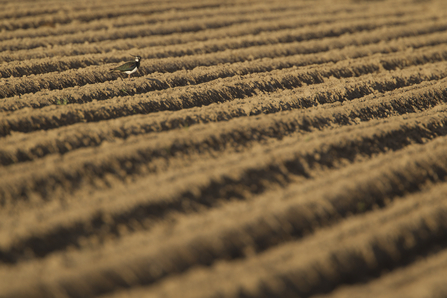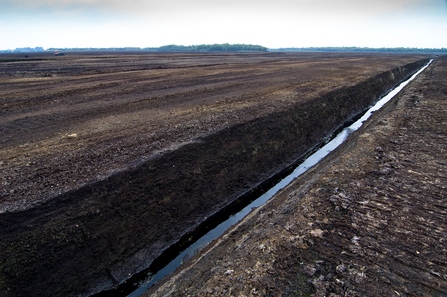Our soils are a precious resource. We depend on them for growing our food, filtering our water and holding back floodwater. They are also a unique wildlife habitat.
Yet over decades our soils have been degraded, putting wildlife and people at risk. Soil health must be put at the heart of how we use and manage our land.
Why are soils important?
Healthy soils are essential for nurturing all wildlife and for our ability to grow food. They’re home to more than 25% of all biodiversity on Earth!
Soils help to:
-
reduce flooding
-
store carbon
-
protect against drought
-
provide a home to wildlife
They are the foundation for our food, clean water, biodiversity and for combatting the climate crisis.
All these things mean that the effective management of our soils is vital to our wellbeing, wildlife and a successful economy. If we continue to degrade soils we will be less able to grow food or source clean drinking water.
Soils are home to more than 25% of all biodiversity on Earth
We also need healthy soils if we’re to meet the target of 30% of land connected, protected and managed for nature’s recovery by 2030.
The British Isles have taken 3 billion years to develop into their current form and include a greater diversity of rock and soil types than anywhere else on Earth of comparable size. However, all across our countryside soils are being eroded and carried out to sea. This is having an impact on wildlife on land, in watercourses, and around our shores.
Healthy soils underpin our food systems, climate and natural ecosystems
If you want to discover more about the importance of soils, read our report 'Digging into our soils', which explores this subject in more detail.
Read Digging into our soils (PDF)
The impact of modern farming on our soils
Much modern farming relies on soil disturbance and adding nutrients to soils to manage weeds and support productivity. Nitrogen- and phosphate-based fertilisers are applied to increase yields, and pollution from transport can also add to nutrient levels.
However, poorly managed and unhealthy soils and their nutrients are easily eroded from farmland. They are then washed down rivers, altering aquatic and marine ecosystems.
Farmers can use many tools to help protect soils such as:
- building organic matter
- minimising soil disturbance
- monitoring soil health
- using legumes to build fertility
- using cover crops so soil is not exposed
- treating farm soil as a corridor for nature, using soil for public education and access opportunities.
The Wildlife Trusts lobby for a range of measures which are necessary to help our soils recover.

Lapwing on farmland ©Mark Hamblin/2020VISION
What The Wildlife Trusts are doing
The Wildlife Trusts are working to restore the health of our soils by:
- advising farmers and landowners to help them to care for their soils
- looking after 100,000 hectares of wildlife-rich sensitively-managed soils on our nature reserves
- restoring peatland soils, for example by blocking drains and rewetting areas of land
- calling for a ban on the use of peat in horticulture.
The Wildlife Trusts lobby for a range of measures which are necessary to help our soils recover. For example, Government should set a target of increasing organic matter in UK arable and horticultural soils by 20% over the next 20 years (1% a year) and put measures in place to achieve this, such as:
- Ploughing less often or stopping tillage altogether in some circumstances.
- Replacing artificial fertilisers with natural organic matter.
- Ensuring crop rotation, and planting catch cover crops.
Peatland soils
Peatlands are amazingly wild places, home to birds, insects and unusual plants that aren't found anywhere else. Peatlands provide benefits for people too - the UK’s peatlands store around 3.2 billion tonnes of carbon, and we get 70% of our drinking water from peatland river catchments.
Peatlands are wetland habitats formed over peat soils. They’re made up of a mix of partly decomposed plant materials, in particular the 'bog mosses' that are a key feature of peatlands. Peat takes thousands of years to form - plant material decays very slowly in wet conditions and gradually becomes compressed into peat, millimetre by millimetre.
Peatlands are tough places to live but wildlife still thrives here including colourful sphagnum mosses, beautiful large heath butterflies and the black darter dragonfly. Peatlands provide important nesting and feeding grounds for many wading birds such as dunlin, curlew and greenshank.

Peat extraction site, Lancashire (Matthew Roberts)
Drainage of our peatlands
Sadly, our peatlands have been suffering for many years and currently around 80% of the UK's peatland are in poor condition. A major cause of damage in the uplands is drainage, where channels are cut into the peat to move rainwater off the land, drying it out to enable sheep grazing, grouse shooting or tree plantations.
Damage can also be caused by burning, air pollution and over-grazing by sheep themselves. Many lowland peatlands are drained for farming, and in some lowland areas, peat sadly continues to be cut or dug out to make compost, sold in garden centres or used in commercial horticulture.
The Wildlife Trusts are working across the country to restore these amazing habitats.
Peat in horticulture
Peat has been a major ingredient of compost sold for gardening for many years. This peat is dug out of wild places, damaging some of our last remaining peatlands here in the UK and overseas in places like eastern Europe. This process also releases carbon into the atmosphere, accelerating climate change.
But peat-free compost is available – if everyone used it our peatlands would be safe from this type of damaging practice. By buying peat free you’re helping our precious peatlands and sending a message to manufacturers that people want peat free products. Both are really important.
Our campaign to ban peat compost
Peat-based compost is not the only problem in our horticulture supplies. The UK also uses a significant amount of lowland peat soils to produce the nation’s vegetables. Those soils need to be rewetted to protect the carbon stores and restore the wildlife.
Our latest news and blogs on soil

Journeying the peatland way
Join Rob Stoneman, Director of Landscape Recovery, as he journeys through a history of peatland recovery and restoration in the UK – and…

Vast areas of peatland destroyed since peat ban announced exactly 3 years ago
It has been three years since the UK Government announced that it would ban the sale of peat for use in the amateur gardening sector,…

Healthy soil – the ultimate essential infrastructure
As the Wildlife Trusts head off to the regenerative farming event Groundswell, where soil health rightly takes centre stage, Vicki Hird…
Our reports on soil
Case studies
Delve into some Wildlife Trust projects working to restore precious soils.
